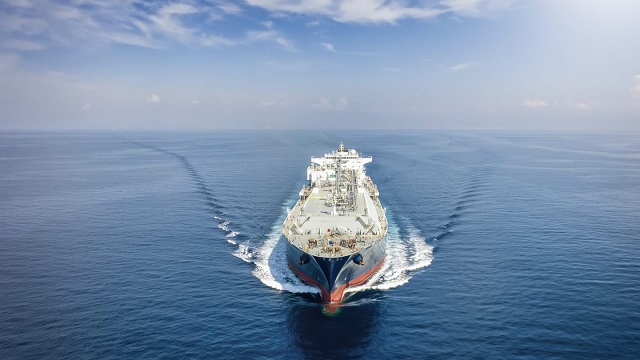Canadian Energy Centre
Report outlines how Canada can get credit for reducing emissions in Asia with LNG

From the Canadian Energy Centre
By Cody Ciona and Deborah Jaremko
Sharing emissions reductions through Article 6 is possible when LNG replaces coal in power generation
With Asian countries continuing to rely on coal to fuel their growth, Canada can provide a cleaner alternative while having its efforts to reduce emissions recognized by the global community, says a new report.
Canada is getting closer to exporting some of the lowest-emitting liquefied natural gas (LNG) on the planet, with the first terminal nearing completion in British Columbia.
A Canadian think tank argues providing a significantly cleaner alternative to coal should merit credit for helping Asian countries reduce emissions under a global climate treaty.
“Sharing emissions reductions through Article 6 [of the Paris Agreement] is possible when LNG replaces coal in power generation,” writes Jerome Gessaroli, a senior fellow with the Macdonald Laurier Institute.
“New LNG projects within British Columbia are amongst the least carbon-intensive sources of LNG in the world. BC’s LNG exports could lower global carbon emissions by displacing coal power, particularly in the Asia-Pacific region.”
Adopted by the United Nations Framework Convention on Climate Change in 2015, the Paris Agreement was ratified by Canada on October 5, 2016. This agreement set forth the worldwide effort to mitigate the effects of climate change.
Article 6 outlines that countries may pursue “voluntary cooperation” with others to implement their nationally determined efforts to reduce emissions.
Coal use and coal plant construction are increasing each year in Asia as countries look to grow their economies.
The increase in coal-fired power has ostensibly created a significant challenge to meeting climate targets as emissions from announced and planned plants alone are expected to be over 1,415 million tonnes of CO2 equivalent.
“Just over half of LNG Canada’s Phase 1 production capacity in British Columbia would result in approximately 1.2 Mt CO2e emissions annually,” Gessaroli writes.
“Using the same production capacity to replace coal for power generation in Asia has the potential to significantly reduce emissions, ranging from 14.9 to 35.2 Mt CO2e per year. Such outcomes underscore the importance of international collaborative efforts.”
Studies have concluded that LNG from Canada can provide a net benefit in emissions reduction when switching from coal.
Last year, global energy research and consultancy firm Wood Mackenzie found that Canadian LNG could reduce net emissions in northeast Asia by an average of 188 million tonnes per year between 2022 and 2050.
That’s three times the emissions of the entire province of B.C., which were 62 Mt in 2021, according to the provincial inventory.
“If Article 6 is used, the assertion that British Columbia’s pursuit of LNG production would prevent the province from meeting its emission reduction becomes inaccurate,” Gessaroli said, noting Canada should announce its intent to use Article 6 as a tool to help meet its emissions reduction targets.
“These are complex issues, but we can learn from other countries that have already established processes for managing such projects.”
Alberta
The Canadian Energy Centre’s biggest stories of 2025

From the Canadian Energy Centre
Canada’s energy landscape changed significantly in 2025, with mounting U.S. economic pressures reinforcing the central role oil and gas can play in safeguarding the country’s independence.
Here are the Canadian Energy Centre’s top five most-viewed stories of the year.
5. Alberta’s massive oil and gas reserves keep growing – here’s why

The Northern Lights, aurora borealis, make an appearance over pumpjacks near Cremona, Alta., Thursday, Oct. 10, 2024. CP Images photo
Analysis commissioned this spring by the Alberta Energy Regulator increased the province’s natural gas reserves by more than 400 per cent, bumping Canada into the global top 10.
Even with record production, Alberta’s oil reserves – already fourth in the world – also increased by seven billion barrels.
According to McDaniel & Associates, which conducted the report, these reserves are likely to become increasingly important as global demand continues to rise and there is limited production growth from other sources, including the United States.
4. Canada’s pipeline builders ready to get to work
Canada could be on the cusp of a “golden age” for building major energy projects, said Kevin O’Donnell, executive director of the Mississauga, Ont.-based Pipe Line Contractors Association of Canada.
That eagerness is shared by the Edmonton-based Progressive Contractors Association of Canada (PCA), which launched a “Let’s Get Building” advocacy campaign urging all Canadian politicians to focus on getting major projects built.
“The sooner these nation-building projects get underway, the sooner Canadians reap the rewards through new trading partnerships, good jobs and a more stable economy,” said PCA chief executive Paul de Jong.
3. New Canadian oil and gas pipelines a $38 billion missed opportunity, says Montreal Economic Institute

Steel pipe in storage for the Trans Mountain Pipeline expansion in 2022. Photo courtesy Trans Mountain Corporation
In March, a report by the Montreal Economic Institute (MEI) underscored the economic opportunity of Canada building new pipeline export capacity.
MEI found that if the proposed Energy East and Gazoduq/GNL Quebec projects had been built, Canada would have been able to export $38 billion worth of oil and gas to non-U.S. destinations in 2024.
“We would be able to have more prosperity for Canada, more revenue for governments because they collect royalties that go to government programs,” said MEI senior policy analyst Gabriel Giguère.
“I believe everybody’s winning with these kinds of infrastructure projects.”
2. Keyera ‘Canadianizes’ natural gas liquids with $5.15 billion acquisition

Keyera Corp.’s natural gas liquids facilities in Fort Saskatchewan, Alta. Photo courtesy Keyera Corp.
In June, Keyera Corp. announced a $5.15 billion deal to acquire the majority of Plains American Pipelines LLP’s Canadian natural gas liquids (NGL) business, creating a cross-Canada NGL corridor that includes a storage hub in Sarnia, Ontario.
The acquisition will connect NGLs from the growing Montney and Duvernay plays in Alberta and B.C. to markets in central Canada and the eastern U.S. seaboard.
“Having a Canadian source for natural gas would be our preference,” said Sarnia mayor Mike Bradley.
“We see Keyera’s acquisition as strengthening our region as an energy hub.”
1. Explained: Why Canadian oil is so important to the United States

Enbridge’s Cheecham Terminal near Fort McMurray, Alberta is a key oil storage hub that moves light and heavy crude along the Enbridge network. Photo courtesy Enbridge
The United States has become the world’s largest oil producer, but its reliance on oil imports from Canada has never been higher.
Many refineries in the United States are specifically designed to process heavy oil, primarily in the U.S. Midwest and U.S. Gulf Coast.
According to the Alberta Petroleum Marketing Commission, the top five U.S. refineries running the most Alberta crude are:
- Marathon Petroleum, Robinson, Illinois (100% Alberta crude)
- Exxon Mobil, Joliet, Illinois (96% Alberta crude)
- CHS Inc., Laurel, Montana (95% Alberta crude)
- Phillips 66, Billings, Montana (92% Alberta crude)
- Citgo, Lemont, Illinois (78% Alberta crude)
Alberta
Alberta’s huge oil sands reserves dwarf U.S. shale

From the Canadian Energy Centre
By Will Gibson
Oil sands could maintain current production rates for more than 140 years
Investor interest in Canadian oil producers, primarily in the Alberta oil sands, has picked up, and not only because of expanded export capacity from the Trans Mountain pipeline.
Enverus Intelligence Research says the real draw — and a major factor behind oil sands equities outperforming U.S. peers by about 40 per cent since January 2024 — is the resource Trans Mountain helps unlock.
Alberta’s oil sands contain 167 billion barrels of reserves, nearly four times the volume in the United States.
Today’s oil sands operators hold more than twice the available high-quality resources compared to U.S. shale producers, Enverus reports.
“It’s a huge number — 167 billion barrels — when Alberta only produces about three million barrels a day right now,” said Mike Verney, executive vice-president at McDaniel & Associates, which earlier this year updated the province’s oil and gas reserves on behalf of the Alberta Energy Regulator.
Already fourth in the world, the assessment found Alberta’s oil reserves increased by seven billion barrels.
Verney said the rise in reserves despite record production is in part a result of improved processes and technology.
“Oil sands companies can produce for decades at the same economic threshold as they do today. That’s a great place to be,” said Michael Berger, a senior analyst with Enverus.
BMO Capital Markets estimates that Alberta’s oil sands reserves could maintain current production rates for more than 140 years.
The long-term picture looks different south of the border.
The U.S. Energy Information Administration projects that American production will peak before 2030 and enter a long period of decline.
Having a lasting stable source of supply is important as world oil demand is expected to remain strong for decades to come.
This is particularly true in Asia, the target market for oil exports off Canada’s West Coast.
The International Energy Agency (IEA) projects oil demand in the Asia-Pacific region will go from 35 million barrels per day in 2024 to 41 million barrels per day in 2050.
The growing appeal of Alberta oil in Asian markets shows up not only in expanded Trans Mountain shipments, but also in Canadian crude being “re-exported” from U.S. Gulf Coast terminals.
According to RBN Energy, Asian buyers – primarily in China – are now the main non-U.S. buyers from Trans Mountain, while India dominates purchases of re-exports from the U.S. Gulf Coast. .
BMO said the oil sands offers advantages both in steady supply and lower overall environmental impacts.
“Not only is the resulting stability ideally suited to backfill anticipated declines in world oil supply, but the long-term physical footprint may also be meaningfully lower given large-scale concentrated emissions, high water recycling rates and low well declines,” BMO analysts said.
-

 International2 days ago
International2 days agoGeorgia county admits illegally certifying 315k ballots in 2020 presidential election
-

 Haultain Research2 days ago
Haultain Research2 days agoSweden Fixed What Canada Won’t Even Name
-

 Business2 days ago
Business2 days agoWhat Do Loyalty Rewards Programs Cost Us?
-

 Energy2 days ago
Energy2 days agoWhy Japan wants Western Canadian LNG
-

 Business2 days ago
Business2 days agoLand use will be British Columbia’s biggest issue in 2026
-

 Business2 days ago
Business2 days agoThe Real Reason Canada’s Health Care System Is Failing
-

 Business2 days ago
Business2 days agoDark clouds loom over Canada’s economy in 2026
-

 Business2 days ago
Business2 days agoFederal funds FROZEN after massive fraud uncovered: Trump cuts off Minnesota child care money





